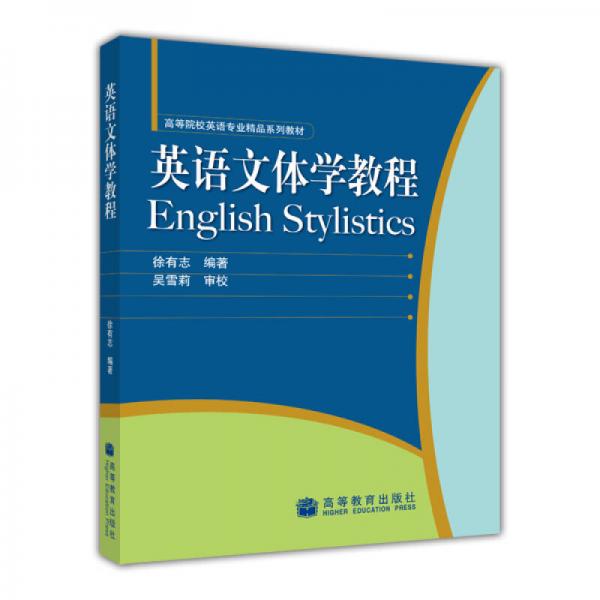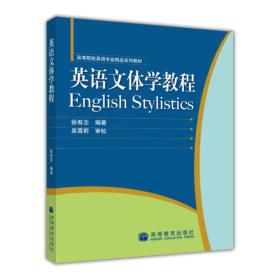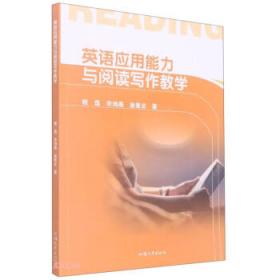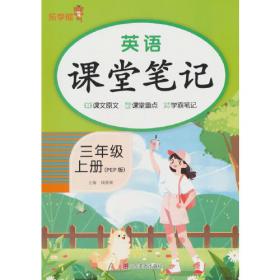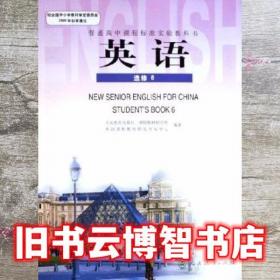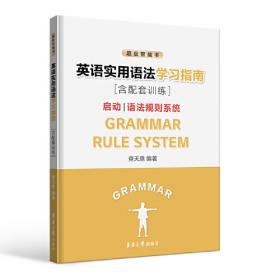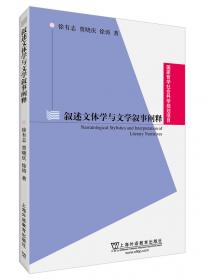英语文体学教程
出版时间:
2005-03
版次:
1
ISBN:
9787040171426
定价:
29.90
装帧:
平装
开本:
16开
纸张:
胶版纸
页数:
321页
字数:
500千字
104人买过
-
《英语文体学教程》 (初版为《现代英语文体学》)本着基础理论与实践并重的原则,简明阐述了当代文体学的理论框架和语言分析方法,具体探讨了语言使用的场合特征与语言特征的相互关系,详细分析了各体英语(包括方言和语域,主要是语域)的语言特点,重点指明了不同体裁文学作品(包括小说、戏剧和诗歌)的文字特色。本书对初步掌握文体学理论概貌和语言描述方法,系统了解各体英语特点,提高恰当运用英语的交际能力,逐步熟悉不同体裁文学作品的语言风格,加深对文学作品的理解和欣赏,无疑将起到一定的作用。本书可供大学英语专业高年级学生使用,也可供攻读硕士学位的研究生和其他英语工作者参考。《英语文体学教程》的编著者徐有志同志是英语语言文学资深教授、博士生导师,长期从事文体学教学与研究,在美进修期间又得到语言学博JsCarolyn Dirksen教授及人类学博J:Murl Dirksen教授的帮助。本书初版手稿曾由河南大学外语系名誉主任、英语语言文学研究所所长、博士生导师,华籍美人ShirleyWood教授审校,经中山大学外国语学院博士生导师王宗炎教授审阅并作序。 The Concern of Stylistics 1
1.1 Stylistics 2
1.2 Language 3
1.3 Aspects ofthe Speech Event 4
1.4 Language Varieties and Function 5
1.5 Style 7
1.6 The Study ofStyle 9
1.7 The Concern of Stylistic Study 7 7
1.8 Stylistics and Other Spheres of Study 1 2
2 The Need for Stylistic Study 14
2.1 Stylistic Study Helps Cultivate a Sense of Ap..
propriateness 1 5
2.2 Stylistic Study Sharpens the Understanding
and Appreciation of Literary Works 7 7
2.3 Stylistic Study Helps Achieve Adaptation in
Translation 21
3 Varieties of Language 24
3.1 Two Kinds ofVarieties 25
3.2 Dialects 26
3.3 Registers 32
3.4 The Mutual Dependence Between Register and
Dialect 38
3.5 The Social Meaning of Language Varieties 39
4 Linguistic Description 41
4·l The Aims of Stylistics in Linguistic Descrip-
tion 42
4.2 Levels of Language 42
4.3 Stylistic Features 44
4.4 Procedure of Linguistic Description 68
4.5 The Practical Description and Analysis This Book 69
5 Formal vs Informal Language 72
5.1 The Interpersonal Function of Language 73
5.2 Degres of Formality 74
5.3 Functional Tenor and Degress of Formality
76
5.4 Matin Joes\\\"Classification 78
5.5 Speech Situation and Formality 80
5.6 Formality and Linguistic Features 82
5.7Sets of Co-occurring Features 86
5.8 Involved vs Informational Texts 87
5.9 Tenors, Field ,and Mode 89
6 Spoken vs Written Language 91
6.1 Striking Differences 92
6.2 Stylistic Differences 94
6.3 Examples of Contrast 98
6.4 More Delicate Distinctions Amongst Modes of Discourse
100
6.5 Mode ,Field ,and Tenors
7 The English of Conversation 105
7.1 Necessity of Studying Speech 106
7.2 Necessity of Sudying Conversation 106
7.3 Object of Study 106
7.4 An Adapted Way of Transcription 108
7.5 A Sample Text of Casual Conversation 108
7.6 General Features 109
7.7 Stylistic Features in Terms of Levels of Language 110
7.8 Summary 118
7.9 Other Kinds 0t Conversation 1 1 9
8 The English of Public Speech 121
8.1 Scope of Public Speech 122
8.2 A Sample Text for Analysis 122
8.3 General Features of Public Speech 124
8.4 Stylistic Features of Public Speech 124
9 The English of Advertising 135
9.1 Advertising English as a Variety 136
9.2 Newspaper Advertising 137
9.3 Radio Advertising 154
10 The English of News Reporting 157
l 0.1 The English of News Reporting as a Variety
158
10.2 Two Sample Texts for Analysis 158
1 0.3 General Features of Newspaper Reporting
763
10.4 Stylistic Features of Newspaper Reporting
763
10.5 Stylistic Features of Radio and Television
News 176
1 1 The English of Science and Technology 180
1 1.1 The Scope of the English of Science and Tech-
nology 181
1 1.2 Sample Texts for Analysis 181
l 1.3 General Features of EST 785
1 1.4 Stylistic Features of EST 1 86
1 1.5 Features of Spoken EST 198
12 The English of Legal Documents 200
12.1 The English of Legal Documents as a Variety
201
12.2 Sample Texts for Analysis 201
1 2.3 Stylistic Features of Legal English 206
13 The English of Literature(I)
一General Remarks 218
13.1 Literature as Language Art 219
13.2 Literary Language and Ordinary Language
219
1 3.3 Literary English as fl Variety 224
14 The English of Literature(II)
___——The Language of Fiction 226
14.1 Manipulation of Semantic Roles 228
14.2 Creation of Images and Symbols 231
14.3 Preference in Diction 232
14.4 Artistic Manipulation of Sentence Variety and
Rhythm 234
14.5 Employment of Various Points of View
239
14.6 The Subtle Workings of Authorial Tone
247
14.7 Various Ways of Presenting Speech and
Thought 242
15 The English of Literature(III)
——-The Language of Drama 247
15.1 Manipulation of the Naturalness of Characters\\\"
Speech 249
1 5.2 Exploitation of Different Speech Act.Turn-
taking and Politeness Patterns 253
1 5.3 Use of Assumptions,PresuppositiOns and
Conversational Implicature 262
16 The English of Literature(IV)
·。——The Language of Poetry 269
1 6.1 Various Devices for Compression 270
16.2 Extreme Care in Word Choice 274
1 6.3 Free Arrangement of Word Order 277
16.4 Lexical and Syntactical Repetition 278
1 6.5 Full Manipulation of Sound Effects 279
1 6.6 The Manipulation of Sight 288
16.7 Analysis of Poems at All Levels 293
Glossary 300
Bibliography 315
-
内容简介:
《英语文体学教程》 (初版为《现代英语文体学》)本着基础理论与实践并重的原则,简明阐述了当代文体学的理论框架和语言分析方法,具体探讨了语言使用的场合特征与语言特征的相互关系,详细分析了各体英语(包括方言和语域,主要是语域)的语言特点,重点指明了不同体裁文学作品(包括小说、戏剧和诗歌)的文字特色。本书对初步掌握文体学理论概貌和语言描述方法,系统了解各体英语特点,提高恰当运用英语的交际能力,逐步熟悉不同体裁文学作品的语言风格,加深对文学作品的理解和欣赏,无疑将起到一定的作用。本书可供大学英语专业高年级学生使用,也可供攻读硕士学位的研究生和其他英语工作者参考。《英语文体学教程》的编著者徐有志同志是英语语言文学资深教授、博士生导师,长期从事文体学教学与研究,在美进修期间又得到语言学博JsCarolyn Dirksen教授及人类学博J:Murl Dirksen教授的帮助。本书初版手稿曾由河南大学外语系名誉主任、英语语言文学研究所所长、博士生导师,华籍美人ShirleyWood教授审校,经中山大学外国语学院博士生导师王宗炎教授审阅并作序。
-
目录:
The Concern of Stylistics 1
1.1 Stylistics 2
1.2 Language 3
1.3 Aspects ofthe Speech Event 4
1.4 Language Varieties and Function 5
1.5 Style 7
1.6 The Study ofStyle 9
1.7 The Concern of Stylistic Study 7 7
1.8 Stylistics and Other Spheres of Study 1 2
2 The Need for Stylistic Study 14
2.1 Stylistic Study Helps Cultivate a Sense of Ap..
propriateness 1 5
2.2 Stylistic Study Sharpens the Understanding
and Appreciation of Literary Works 7 7
2.3 Stylistic Study Helps Achieve Adaptation in
Translation 21
3 Varieties of Language 24
3.1 Two Kinds ofVarieties 25
3.2 Dialects 26
3.3 Registers 32
3.4 The Mutual Dependence Between Register and
Dialect 38
3.5 The Social Meaning of Language Varieties 39
4 Linguistic Description 41
4·l The Aims of Stylistics in Linguistic Descrip-
tion 42
4.2 Levels of Language 42
4.3 Stylistic Features 44
4.4 Procedure of Linguistic Description 68
4.5 The Practical Description and Analysis This Book 69
5 Formal vs Informal Language 72
5.1 The Interpersonal Function of Language 73
5.2 Degres of Formality 74
5.3 Functional Tenor and Degress of Formality
76
5.4 Matin Joes\\\"Classification 78
5.5 Speech Situation and Formality 80
5.6 Formality and Linguistic Features 82
5.7Sets of Co-occurring Features 86
5.8 Involved vs Informational Texts 87
5.9 Tenors, Field ,and Mode 89
6 Spoken vs Written Language 91
6.1 Striking Differences 92
6.2 Stylistic Differences 94
6.3 Examples of Contrast 98
6.4 More Delicate Distinctions Amongst Modes of Discourse
100
6.5 Mode ,Field ,and Tenors
7 The English of Conversation 105
7.1 Necessity of Studying Speech 106
7.2 Necessity of Sudying Conversation 106
7.3 Object of Study 106
7.4 An Adapted Way of Transcription 108
7.5 A Sample Text of Casual Conversation 108
7.6 General Features 109
7.7 Stylistic Features in Terms of Levels of Language 110
7.8 Summary 118
7.9 Other Kinds 0t Conversation 1 1 9
8 The English of Public Speech 121
8.1 Scope of Public Speech 122
8.2 A Sample Text for Analysis 122
8.3 General Features of Public Speech 124
8.4 Stylistic Features of Public Speech 124
9 The English of Advertising 135
9.1 Advertising English as a Variety 136
9.2 Newspaper Advertising 137
9.3 Radio Advertising 154
10 The English of News Reporting 157
l 0.1 The English of News Reporting as a Variety
158
10.2 Two Sample Texts for Analysis 158
1 0.3 General Features of Newspaper Reporting
763
10.4 Stylistic Features of Newspaper Reporting
763
10.5 Stylistic Features of Radio and Television
News 176
1 1 The English of Science and Technology 180
1 1.1 The Scope of the English of Science and Tech-
nology 181
1 1.2 Sample Texts for Analysis 181
l 1.3 General Features of EST 785
1 1.4 Stylistic Features of EST 1 86
1 1.5 Features of Spoken EST 198
12 The English of Legal Documents 200
12.1 The English of Legal Documents as a Variety
201
12.2 Sample Texts for Analysis 201
1 2.3 Stylistic Features of Legal English 206
13 The English of Literature(I)
一General Remarks 218
13.1 Literature as Language Art 219
13.2 Literary Language and Ordinary Language
219
1 3.3 Literary English as fl Variety 224
14 The English of Literature(II)
___——The Language of Fiction 226
14.1 Manipulation of Semantic Roles 228
14.2 Creation of Images and Symbols 231
14.3 Preference in Diction 232
14.4 Artistic Manipulation of Sentence Variety and
Rhythm 234
14.5 Employment of Various Points of View
239
14.6 The Subtle Workings of Authorial Tone
247
14.7 Various Ways of Presenting Speech and
Thought 242
15 The English of Literature(III)
——-The Language of Drama 247
15.1 Manipulation of the Naturalness of Characters\\\"
Speech 249
1 5.2 Exploitation of Different Speech Act.Turn-
taking and Politeness Patterns 253
1 5.3 Use of Assumptions,PresuppositiOns and
Conversational Implicature 262
16 The English of Literature(IV)
·。——The Language of Poetry 269
1 6.1 Various Devices for Compression 270
16.2 Extreme Care in Word Choice 274
1 6.3 Free Arrangement of Word Order 277
16.4 Lexical and Syntactical Repetition 278
1 6.5 Full Manipulation of Sound Effects 279
1 6.6 The Manipulation of Sight 288
16.7 Analysis of Poems at All Levels 293
Glossary 300
Bibliography 315
查看详情
-
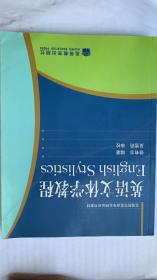 2
2
2010-01 印刷
印次: 9
全新
-
全新
北京市房山区
平均发货8小时
成功完成率81.83%
-
全新
北京市朝阳区
平均发货24小时
成功完成率82.83%
-
 6
6
全新
北京市顺义区
平均发货12小时
成功完成率93.73%
-
全新
北京市海淀区
平均发货56小时
成功完成率72.19%
-
全新
北京市海淀区
平均发货38小时
成功完成率55.56%

 占位居中
占位居中

